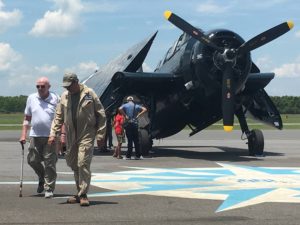
Avenger pilot and friend of Guy Brown, Jr. Dean Boyer walks away from a TBM Avenger like he flew in World War 2. Boyer had just flown for the first time in an Avenger in 70 years.
“He’s not at the top of the ladder, but he’s climbing.” Quote at the bottom of Guy Brown, Jr.’s yearbook photo
Names are carved on a cold stone. Each name has a story behind it. But when the people who know those stories die, the stories are lost. History fades. Time marches on. And the names become only a barren list like from a phone book.
On the World War 2 Memorial in Vicksburg there is a name of a forgotten hero. His name is Guy McElroy Brown, Jr. Brown died a week and a half before the U.S. dropped the atomic bomb on Hiroshima. His parents, who were broken hearted, died five years later 10 days apart. And with their passing, Brown’s story faded away. He became another name on a list.
That is until Clinton Body Shop owner John Mosley decided to buy a World War 2 U.S. Navy bomber called a TBM Avenger. When Mosley decided to paint the plane like a Mississippi pilot’s plane, he discovered Guy Brown’s name. And thanks to exhaustive online research done by Anne Claire Fordice, Brown incredible but short life revealed itself like invisible ink rubbed with an onion.
Guy Brown, Jr., born on June 15, 1917, was the only child of Guy M. Brown, Sr. and Clara Boyd Brown. He grew up off Claremont Street in Vicksburg, Mississippi. He was both gifted athletically and academically and was president of his Junior Class at Carr Central High School. He possessed Hollywood good looks. When Pearl Harbor was attacked on December 7, 1941, Guy did what every red-blooded American did — he enlisted in the Military. Soon he was training in Pensacola, Florida to become a Naval Aviator. He’d be the pilot and crew chief the Navy’s latest bomber, the TBM Avenger, named to avenge Pearl Harbor.
All the while, his mother kept a diary of his service on a tongue-and-grove wall in their basement. He repeatedly flew his plane and its crew into the hellfire of the Japanese antiaircraft fire. Two Distringuished Flying Crosses prove he had the right stuff. His parents were rightfully proud.
While serving on the aircraft carrier USS Shangri La, Brown proved himself to not only to be an expert pilot but also a light-hearted prankster. According to his wingman and friend Dean Boyers, when in port, Brown would be the first to pickup the dates and the last to board the ship. When he’d come aboard, he’d flip up his sleeping shipmates bunks and then use his athleticism to escape, laughing all the way.
On July 28, 1945, Guy Brown made his final flight. His torpedo group was tasked to remove anti-aircraft artillery in a harbor in Japan. He scored a direct hit on his target but at an altitude between 5,000 and 8,000 feet, a Japanese anti-aircraft shell hit its mark. Guy’s wingman saw the Brown’s plane and her crew of three plummet into the sea in two pieces. Charles Edward Smith Jr. and William Harry Winn were also on board. There were no survivors.
John Mosley visited Guy Brown’s old home and met the owners, who were out in the yard. When he told them Brown’s story, they said, “well that makes sense. We have a diary from the war on our wall.” Fellow aviation enthusiast Dan Fordice arranged to have that part of the wall cut out and replaced. The wall diary that his mother so lovingly and then tragically kept now sits in the Southern Heritage Aviation Foundation museum At the Vicksburg-Tallulah airport. It’s worthy of seeing.
Guy Brown’s story lives on thanks to John Mosley’s decision to buy a classic warbird. It also lives on because of the hard work of Ann Claire and Dan Fordice. As long as the Mosley’s TBM Avenger takes flight, Guy Brown, Jr. won’t be just another name on a stone.

As a history buff, I was intrigued to and listened aptly to the story of Guy Brown on MS Public Radio. I had never heard of Guy Brown but so like many others who has given their lives for their country, the media fails to cover their story. I compliment those responsible for this wonderful, heartbreaking story.